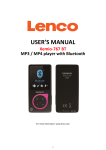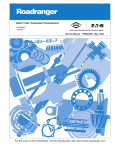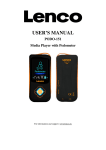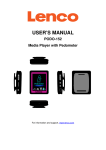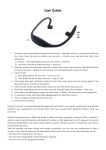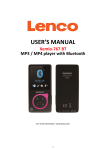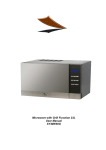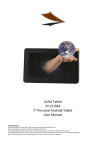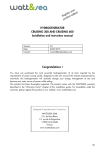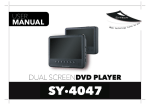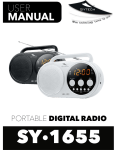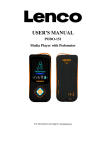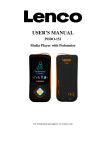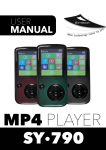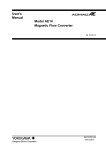Download Center - Sytech
Transcript
1 Welcome Thank you for purchasing the MP4 Player SY-789. In order to fully benefit from this product, please read the safety and operations instructions carefully. Store the user manual in a safe place for future reference. ImportantThe SY-789 includes a pedometer function. This function works independently from the BT wireless function. Note that the BT wireless function will not work when the pedometer is active and vice versa. 2 Cautions • • Do not place naked flames, such as lighted candles on or near the product. Do not place objects filled with liquids, such as vases on or near the product. • Do not use or store this product in a place where it is subject to direct sunlight, heat, excessive dust or vibration. • Do not use this product with wet hands. • Do not clean this product with water or other liquids. • Do not block or cover the slots and holes in the product. • Do not push foreign objects into the slots or holes in the product. • Do not attempt to open this product yourself. There are no user serviceable parts inside. • Do not allow children access to plastic bags. Safety Warnings • • Before using this product, read and follow all warnings and instructions. This product is not intended for use by young children. Young children should be properly supervised. • This product is intended for household use only and not for commercial or industrial use. • Do not expose to dripping or splashing. • No naked flame sources, such as lighted candles, should be placed on the product. • Ventilation should not be impeded by covering ventilation openings with items such as newspapers, table cloths, curtains and the like. • Make sure the unit is adjusted to a stable position. Damage caused by using this product in an unstable position or by failure to follow any other warning or precaution contained within this user manual will not be covered by warranty. We, suggest retaining the packaging in case for future transport of the product. If at any time in the future you should need to dispose of this product please note that: All batteries and accumulators need to be removed from this product (Removal of Waste Batteries and Accumulators). WARNING: When participating in the traffic listening to a personal music player can make the listener less aware of potential dangers such as approaching cars. WARNING: To prevent possible hearing damage, do not listen at high volume levels for long periods. 3 1. Get to know the controls on Player 1 3 7 2 4 5 12 8 9 10 6 item Description 1. TFT LCD Display 2. M Button (Menu) 3. Center ( ) Button (On / Off, Play / Pause) 4. Button (Previous / Fast-Rewind) 5. Button (Next / Fast-Forward) 6. Button (Previous Menu / Exit) 7. Earphone Output Jack (3.5mm Stereo) 8. Micro SD Memory Card Slot 9. Micro USB Port (PC Connection / Charge) 10. Microphone Position (mono, inside USB port) 11. Button (Volume Down) 12. Button (Volume Up) 2. About Player Battery 4 11 Player has an internal, non–user-replaceable battery. For best results, the first time you use player, let it charge for about 2 ~ 3 hours or until the battery status icon in the connection screen shows that the battery is in full. Player may continue use battery power after it’s been turned off. For maintain the battery life and performance, if unit isn’t used for a while, the battery need to be recharged, recharging the battery at least once per month. a. Charging the Battery: You can charge the player battery in two ways: • Connect player to your computer. Or, • Use the USB power charger. (not included) b. Connection and Charging: • Once you have connected player with computer / power charger, then you will see the “Choose connection” screen appear to choose. It will switch to “Charge & Transfer” mode automatically if no action in 4 ~ 5 seconds. • Choose “Charge & Transfer” to upload or download the media files with your computer and charging the Player’s battery. • Choose “Charge & Play” to operates the Player’s function and the battery charging in background. • The level bars are running in battery icon at the connection screen. The battery is in charging. “Choose connection” “Charge & Transfer” “Charge & Play” or In Charging Important: 5 - The battery does not charge when your computer is in sleep/off mode. - The USB port on most keyboards does not provide enough power to charge the player. - Connect the player to a USB 2.0 or USB 3.0 port on your computer only to prevent charge problem. 3. Connecting and Disconnecting a. To Connecting Player: • To connect player to your computer, plug the connector of USB Cable into a USB port on your computer, and connect the other end to player; • Then the player is ready for media files transfer with your computer and the battery is charging when “Charge & Transfer” mode is selected. And the connection screen is appearing for view. • Now you can transfer the media files by using the computer mouse use drag and place, or copy and paste, in between the player and your computer. b. To Disconnect the Player: It’s important not to disconnect the player while it’s syncing or transferring files. Eject the player before disconnecting it. • To eject the player, press the M button once, the connection screen will switch to “Main Menu” screen. And now it’s safe to disconnect the player with your computer. Unplug the USB cable from the player. Or, • If you’re using a Windows PC, eject player by “Computer / My Computer” menu or by clicking the “Safely Remove Hardware” icon in the Windows system tray, select the correspondence name of player to eject. • If you’re using a Mac, you can also eject player by dragging the player icon on the desktop to the Trash. • Now is safe to unplug the USB cable. • If you accidentally disconnect player without ejecting it, reconnect it to your computer and sync again. However, some media file may loss. 4. Getting Start the Player Turn ON / OFF and use of Main Menu: • To turn ON the player, press and hold the Center ( ) button for 3 seconds, then you will see any one of the following shown Main Menu screen, “Music 6 / Video / Recording / Voice / FM / Photo / Settings / E-Book / Bluetooth / Pedometer”, will appear on LCD after the Loading and Opening screen have displayed. • To turn OFF the player, press and hold the Center ( ) button for 3 seconds. “Main Menu” Music Video Recording Voice FM Photo Settings E-Book Wireless BT Pedometer 7 5. Use Settings Menu You might need to set date & time or change some default setting as you desire in the setup menu before you start using the player. • To go into settings menu, from main menu, choose “Settings” by using and Center ( ) buttons, a “Settings” menu appears to use; • For back to previous menu or main menu, press or pressing during in setup menu and submenu. / button “Settings” Menu a. Sleep timer: • In Setup menu, choose “Sleep timer”, by using / and Center ( buttons then choose “Off” to switch it off. ( factory default is “Off”) • In Setup menu, choose “Set sleep timer” to switch On the sleep timer, a levels bar with numbers appear to use, then choose “1 ~ 99” (Minutes) as you want by using the / and Center ( ) buttons. • The Player will turn off automatically at the set time. ) b. Display settings: You can set the backlight to illuminate the screen for a certain amount of time as you desired, or make the backlight to “always On” when every time you turn ON the player. 8 • In Setup menu, choose “Display settings” > choose “Backlight timer”, a list appear to use, then chose “10 / 20 / 30 seconds / Always On” as you desired by using / and Center ( ) buttons. Choose “Always On” to prevent the LCD backlight from turning to off. (choosing this option decrease battery performance) • Choose “Screen saver”, > choose “Digital clock” or “Screen off”, to turn On and Off the screen saver function. Chosen “Digital clock” to display the date and time when screen saver if in enabled. c. Date & Time: • In the Setup menu, choose “Date and time” by using ( ) buttons, a list appears to use. / and Center Set Time • Choose “Time settings” to set clock, then choose “Set time format” or “Set time” as you want; • Choose “Set time format” then choose “12 Hours / 24 Hours” show format as you desired. • Choose “ Set time”, a clock interface will appear to set; • The “Hour / Minute” set item is highlighted, press M button to switch in between Hour and Time which you want to set. And adjusting hour and minute to current time by pressing the / button. • Finally, you need to press the Center ( ) button to confirm the adjustment and the screen will back to previous menu. Set Date • Choose “Date settings” to date, then choose “Set date format” or “Set date” as you want; • Choose “Set date format” then choose “YYYY MM DD / MM DD YYYY” which format as you desired. • Choose “ Set date”, a date interface will appear to set; • The “MM / DD / YY” set item is highlighted, press M button to switch in between day, month and year which you want to set. And adjusting them to current date by pressing the / button. • ) button to confirm the adjustment Finally, you need to press the Center ( and the screen will back to previous menu. d. Language: 9 This player can use difference OSD languages. • To set the language, choose “Language”, and then choose which language as you desire by using / and Center ( ) buttons. e. Information: You can view the player information and disk memory status, such as firmware version, remaining memory space available and the number of support media files available in player. • In Setup menu, choose “Information” by using buttons, a list appears to use. • Choose “Player information” or “Disk space” which you want to view. / and Center ( ) f. Factory Settings: • In Setup menu, choose “Factory settings”, a dialog “Restore factory settings?” will pop up to confirm; • Choose “Yes” to confirm. Or, “No” to abort. • Press button to exit Setup menu. 6. Use Wireless-BT Menu • From main menu, choose “Wireless BT” menu by using / and Center ( ) buttons, a Bluetooth list menu “Search Device / Device’s List / All Music / BT Now Playing” will appear to choose after Bluetooth entering screen have displayed; • Before pairing, please make sure your Bluetooth Receiver Device supports Bluetooth A2DP profile. • Keep the device in 1 meter of your Bluetooth receiver device. • Switch On your Bluetooth receiver device and enable it to searching / pairing mode. 10 a. Search Device • Choose “Search Device” to enter into the Bluetooth searching mode by using / and Center ( ) buttons on player, the device searching mode is starting, for approximate 10 ~ 20 seconds, a device(s) name list will appear to choose for pairing. • Choose the device’s name which you want to pair then choose “Pair/Connect” by using / and Center ( ) buttons, wait for few seconds both device should be paired and the first song in music list will playing automatically from you Bluetooth receiver device. And, • The screen is switch to “BT Now Playing” interface and a Bluetooth icon “ “is displaying at the information bar, the Bluetooth is in transmitting. “BT Now Playing” Bluetooth Transmission is On • To search for new Bluetooth Device; • Before you search for a new device, please disconnect the current paired device. For better results, turn the paired Bluetooth receiver to power off. • Choose “Search Device” the device searching mode will start again for new device(s) name list to choose again; • Choose new found and wanted Bluetooth receiver device for pairing. b. Device’s List • Choose “Device’s List” to enter into the paired device list, you can disconnect or un-pair it, also can re-connect those devices if it’s in operating range. • In device’s list, choose the device’s name and choose you desired function “Disconnect” or “Connect / Unpair” as you want. However, make sure that you have disconnected the linking device before connect the new wanted device. • Reconnect a pair Bluetooth device; • Automatically connecting: every time when turn “On” the Bluetooth 11 transmission function, it will automatically reconnect to the last connected device if the receiver device is still in reconnect mode. However, some Bluetooth receiver device may need to turn it “Off and On” again for reconnecting. If not; • Manual connecting: some Bluetooth receiver device may need to reconnect manually; turn it power Off and On again for reconnecting. Or; • Choose “Device’s List” again by using / and Center ( ) buttons, then choose the known device and choose “Connect” for reconnecting. c. All Music • Choose “All Music” to enter into the music list, you can directly select the desired music for playback and transmitting by using / and Center ( ) buttons. d. BT Now Playing • Choose “BT Now Playing” to return to the playing interface. • In “BT Now Playing” interface, you can select; Previous / Next song file, Play / Pause the song and adjust the Volume Up/Down by using / , Center ( ) and / buttons respectively. To Recall the Bluetooth’s Submenu / Exit Bluetooth Function • Press • Pressing button until a “Exit BT Transmission?” dialog appear for confirm. Choose “Yes” to exit by using / and Center ( ) buttons, the Bluetooth function will turn Off and return to main menu screen. Choose “No” to abort. button, to recall the Bluetooth’s submenu. Or, Bluetooth Function Limitation: 1. When you turn the player into Bluetooth audio transmitting mode, the player earphone output sound will turned to Off automatically; 2. Only music format files with MP3, WMA and WAV can be transmitting by the player’s Bluetooth function in music playing interface mode. 3. Fast-Forward and Fast Backward is not allowed to use in Bluetooth mode. 7. Use Music Menu You can use this music player to playback with almost full format of music file of audio coding. To open the music player in Main Menu: 12 • From main menu, choose “Music” by using buttons, a list menu appears to use; / and Center ( ) a. All Songs • Choose “All song / Artists / Albums / Genres / Update Playlist” as you desired; • Choose “All song” to enter all songs list menu to select a song where start the play. (Depend on current location of Local Folder and Card Folder last chosen. And default is Local folder if Micro SD card is not inserted) b. Artist • Choose “Artists” to enter folder(s) list menu grouping by Artist name, then choose who name of Artist folder > choose a song file in list where start the play. c. Albums • Choose “Albums” to enter folder(s) list menu grouping by Album name, then choose who name of Album folder > choose a song file in list where start the play. d. Genres • Choose “Genres” to enter folder(s) list menu grouping by Genres name, then choose who name of Genres folder > choose a song file in list where start the play. e. Update playlist • Choose “Update playlist” to update the playlist when you found it show incorrect; actually, it is normal due to some media files could be manual deleted in player’s memory by user in some case. However, update the playlist when necessary. f. Local Folder • Choose “Local Folder” to use player’s internal memory as current location, you will see all supported song files will list out in playlist when item selected. g. Card Folder • Choose “Card Folder” to use Micro SD Card memory as current location, you will see all supported song files will list out in playlist when item selected. However, a “Create list or not” will appear to confirm when every time the Micro SD Card is plug in and used. Choose “Yes” to process, a playlist will be generated for use. Choose “No” to abort. 13 Remark: The “Local Folder” and “Card Folder” items are will be existed only in music menu when Micro SD card has plugged into the player. In Music “Now playing” interface, press M button, a music submenu “Play mode/Equalizer/Delete” appears. “Music Menu” “Music Now Playing Interface” “Music Submenu Menu” h. To Play Music • In All songs / Artists / Albums / Genres list menu, choose a song file to star the play using by using / and Center ( ) buttons. Then the music now playing interface will appears to view and use; i. Play / Pause Song • In music now playing interface; • Press Center ( ) button to pause the playing music. Press it again to resume. j. Next / Fast-forward and Previous / Fast-backward Song file • Press button to play next music. • Press button to play previous music. • Press and hold button to use fast-forward • Press and hold button to use fast-backward. k. Adjust volume level 14 • Press or pressing / button to adjust volume levels to up / down and a volume control screen is appear for viewing. • Wait for 6 seconds or press screen. button to return to music now playing For hearing protection; a display warning pop-up on TFT screen, when first time to increase the volume level and reach to the default setting level which may exceed 85dB. Press M button to accept the warning and enter into the volume control for increase the level and until to maximum level. l. Use Lyric Display This player supports “*.LRC” lyric files and lyrics can synchronous displayed while playing music if you music file has lyric file included together. • Make sure the music file name and the “*.LRC” file name must be same and upload into player together. The embedded lyric song file will not display lyric. • When the playing music included with lyrics file, then the lyrics display mode will switched on automatically and the lyrics will display at the music now playing interface. 8. Use Movie Menu • From Main Menu, choose “Movie” by using buttons, a files list appears to choose; / and Center ( ) • Choose the desired movie file to start the play and the screen switch to movie now playing screen. The movie is playing automatically. a. Play /Pause Movie • In movie now playing screen, press Center ( ) button to pause. • Press it again to resume. • Press button to go back files list screen for choose another movie file to play if you want it. b. Play Previous or Next Movie file • Press button to play next movie file. • Press button to play previous movie file. c. Fast-Forward or Fast-Backward • Press and hold button to play fast-forward. 15 • Press and hold button to play fast-backward. d. Adjust Volume Level • In movie now playing screen, • Press or pressing to increase the volume level. • Press or pressing button to decrease the volume level. • Then, press Center ( ) button to back to movie now playing. For hearing protection; a display warning pop-up on display screen, when first time to increase the volume level and reach to the default setting level which may exceed 85dB. Press M button to accept the warning and enter into the volume control for increase the level and until to maximum level. 9. Use Movie Submenu You might need to change the play mode or delete some unwanted movie files. To do this: In movie now playing screen, press M button, a movie submenu “Repeat / Delete video / Update Playlist” is appear to choose; a. Repeat: Choose “Repeat” > choose “Repeat off / Repeat 1 / Repeat all” as you desired play mode by using / and Center ( ) buttons. b. Delete Video: • Choose “Delete Video” by using / and Center ( ) buttons; • A “video name…” delete? dialog is appear to confirm, choose “Yes” to confirm delete the current song file in memory; • A “deleting” dialog is appears for few seconds and the current song file is deleted. And the next movie’s file is selected to play automatically. • Choose “No” to abort. c. Update playlist: • Choose “Update playlist” to update the playlist when you found it show incorrect; actually, it is normal due to some media files could be manual deleted in player’s memory by user in some case. However, update the playlist when necessary. 10. Convert Video files into AMV/AVI If your video file is different or you found format error, convert it to the correct 16 format through the included “AMV&AVI Video converter” as follows. This tool can be used to transform those video files into AMV/AVI files on the computer before upload them to your player. (Recommended use AMV) Important: For Video Converter, please make sure you have installed Microsoft DirectX 9.0 or above. When to convert Real Media, QuickTime, MPEG format video files, please install related DirectShow filter at first. Otherwise, AVI Converter cannot work normally. For Media Manager in Windows XP and Windows 2003, please make sure you have installed Microsoft Media Player 10.0 or above, and Microsoft .NET framework 3.0. • To install this video convert tool to your computer, open a folder named “UTILITIES > Video Conversion Software” which stored in your player’s internal memory or stored in a provided CD. (Download it onto your computer for copy and installation) • Select “Setup” to start the install program, the software will automatically install to your computer. • After installation is done, open folder “Media Player Utilities 4.39” > click program “AMV&AVI Video converter” in All Program bar on your window PC. The program interface as shown below: Noted: This program is used to convert video files into AMV/AVI format, currently AMV/AVI format are supported by this player. • Then click to choose the folder where to save the AMV/AVI files, and then click to select the folder where the original files are. The original file will show in the file window once selected. 17 • Move the mouse arrow and left click mouse on the unconverted source files to select with highlight in the file window, then the icon will be highlighted into icon. Now click this icon and a dialog box will be shown. • Now click this icon and a dialog box will be shown. • Make sure Video type is “AMV/AVI”, Screen width and height is “160x120 / 320x240” selected. Video convert and Image quality should be “Normal” and “High” as defaulted. Click “OK” to confirm the setting. • Now click to start converting. 18 • After conversion, the converted files will play automatically for preview if AMV format has selected. • And now, the converted AMV/AVI file is ready to transfer, you can simply copy and place those converted files to the media player. Note: Only pixels in “160x120 / 320x240 (max.)” can be supported by this player. 11. Use Recording Menu You can use the player as a Voice Recorder and recording voice memos using the built-in microphone. Besides, look for the recorded file(s) and playback them in same menu. To do this: • From main menu, choose “Recording” by using buttons, a list menu appear to choose; / and Center ( ) a. Start Voice Recording: • From list menu, choose “Start Voice Recording”, a “Now Recording” screen appear to view and it is in recording; “Now Recording” Screen b. Storage: • From list menu, choose “Storage” > Choose “Internal Memory / External / and Memory” where to store the record file as you desired by using Center ( ) buttons. • The list will switch back to recording menu once storage location selected. 19 Note: 1. This “Storage” item will be existed only when Micro SD card has plugged into the player, it skips if no card plugged. 2. The storage defaulted folder will be located as name “RECORD” in “Internal Memory” of player or “External Memory” of Micro SD Card. c. Record Format: • From list menu, choose “Record Format” > Choose “MP3 format / WAV format” as you desired for recording. d. Record Settings: • From list menu, choose “Record Settings” > Choose “Set REC bitrate”, a list menu appear to choose; • Then choose “32kbps/ 64kbps / 128kbps / 192kbps” if MP3 record format is chosen. Or, • Choose “512kbps / 768kbps / 1024kbps / 1536kbps” if WAV record format is chosen. Remark: higher number of kbps will higher the recording quality but will use more memory capacity in recording file. e. To playback the recorded file • Use the “Voice” menu to playback the recorded file in Voice recording or FM recording function; • Please read the “Item 12, Use Voice Menu” use methods for playback you desired Voice/FM recorded file. 12. • Use Voice Menu From main menu, choose “Voice” menu > choose “Local folder” or “Card folder” > choose a desired “Voice Recorded File (REC00x.*)” or “FM Recorded file (FMREC00x.*)” which want to playback by using / and Center ( ) buttons; • The screen switch to Voice Now Playing screen and the selected file will play automatically. “Voice Now Playing” Screen 20 a. Play and Pause Recorded file • In Voice Now Playing screen, press Center ( • Press it again to resume. ) button to pause. b. Play Previous or Next File • Press button to play next file. • Press button to play previous file. c. Play Fast-Forward or Fast-Backward • Press and hold button to use fast-forward • Press and hold button to use fast-backward. d. Adjust volume level • Press or pressing to increase the volume level. • Press or pressing button to decrease the volume level. • Then, press Center ( ) button to back to movie now playing. For hearing protection; a display warning pop-up on display screen, when first time to increase the volume level and reach to the default setting level which may exceed 85dB. Press M button to accept the warning and enter into the volume control for increase the level and until to maximum level. e. Delete File • In file list screen or Voice Now Playing screen, press M button a “Delete ?” dialog box appear to confirm. Choose Yes to confirm or No to abort. • The selected file or current playback file will be deleted once Yes is selected and confirmed. 13. Use FM Radio This player is using the wire of earphone set as antenna for FM radio, plug in the earphone set into the earphone output jack before searching for FM stations. • From main menu, choose “FM” by using a “Radio Tune” screen appears to use; 21 / and Center ( ) button, “Radio Tune” Screen a. Adjust Volume Level • Press or pressing / button to increase the volume level. • Press or pressing / button to decrease the volume level. • The volume control screen will disappear in 6 ~ 8 seconds. Or, press button to return to music now playing screen. For hearing protection; a display warning pop-up on display screen, when first time to increase the volume level and reach to the default setting level which may exceed 85dB. Press M button to accept the warning and enter into the volume control for increase the level and until to maximum level. b. Manual Search Stations • In Radio Tune screen; • Press / button for searching frequency down or up to receive next station, each press will step down or up the frequency by 0.1MHz. • Press / station. Or; button quickly until to your desired radio frequency of radio • Press and hold / button for 2 ~ 3 seconds to enter into manual searching mode. This mode allows keeping searching down / up and be stop until next station received. • To save the receiving radio station, please refer to item 14-c (Save to preset) mentioned below. c. Change Stored Radio Stations From Channel List • Once you have tuned and stored the radio station into channel list by Manual tune / Auto tune function; and then you can recall them by press or pressing Center ( ) button. • The channel number will change and cycle up from low numbers when each ) button, the stored radio stations will time you press or pressing Center ( change for listen accordingly. 22 14. Use FM Radio Submenu • In radio tune screen, press M button to call up the FM Radio submenu, a list screen “Start FM recording / Presets / Save to preset / Clear preset / Auto tune / FM REC Library” is appears to use. • Press / button to choose one of them and then press Center ( button to entering. ) a. Start FM recording • In FM Radio submenu, choose “Start FM recording” to enter the FM recording function under in the radio mode, the screen will switch to Now Recording screen and starting the FM recording automatically. • Press Center ( ) button to pause the FM recording, press it again to resume if you want. • To save and stop the FM recording file, press recording?” dialog pop up to confirm; button, a “Save • Choose “Yes” to confirm, the recorded file will save into defaulted folder and back to the list menu for next action. • Choose “No” to abort. b. Presets • Before you can use the “Presets” submenu function, first you have already save the desired radio stations by using the “Manual Search” and “Save to preset” or “Auto tune” function. • If not, the preset submenu will show “FM --/--” in all location from 01 ~ 30, which mean no radio station were preset. • You can select the desired preset radio station frequency if the radio station were saved in list; • However, the preset channel list like below will show for example: 01 FM 89.50 02 FM 92.10 03 FM 94.40 04 FM 96.90 23 05 FM 98.90 06 FM 101.80 07 FM --/-08 FM --/-• Then choose one of them, example 01, as you desired radio station for listen by using / and Center ( ) buttons. c. Save to preset • In FM Radio submenu, choose “Save to preset” by using / and Center ( ) buttons to store the tuned radio station or current listening station into player’s memory, the preset channels list appear to use; • Then choose which preset channel number, location 01 ~ 30, you want to save by using / and Center ( ) buttons, a “Save xx.xx FM to preset xx” dialog pop up to confirm. • Choose “Yes” to confirm, the station will be stored at wanted location in preset channels list accordingly. • Choose “No” to abort. Preset Channel Number Station’s Frequency Note: In preset channels list, there have total 30 numbers of preset channel, “01 – 30”, what can be used to store the wanted radio stations. d. Clear preset • In FM Radio submenu, choose “Clear preset” by using / and Center ( ) buttons to erase the unwanted radio station(s) or current listening station from preset channels list; • Then choose a number of preset location, 01 ~ 30, which want to erase from appearing preset channels list by / and Center ( ) buttons, a “Clear preset xx?” dialog pop up to confirm. • Choose “Yes” to confirm. Or choose “No” to abort. e. Auto tune 24 • In FM radio submenu, choose “Auto tune” by using / and Center ( ) buttons to enter to auto tune and auto preset mode, a dialog window pop up to confirm; • Choose “Yes” to start the searching function and the radio will automatically searching stations in the range of frequency “87.5MHz - 108MHz” depending on region which set. • However, all found radio stations will be stored at the preset channels list in player’s memory and the radio searching function will stop and show the first received radio station for listening. • From appearing preset list, selects one of the channel numbers to listen the desired radio station. Or, press button to return to radio tune screen. f. To Playback the FM recorded file • Use the “Voice” menu to playback the recorded file in Voice recording or FM recording function; • Please read the “Item 12, Use Voice Menu” use methods for playback you desired Voice/FM recorded file. 15. Use Photo Menu You can use the player as photo / picture viewer, to browse files: • From main menu choose “Photo” by using a list menu appear to use; / and Center ( ) buttons, a. Play file • In list menu, choose a file to start the play. • Press button to go back to list menu for other file selection. b. Change previous / next file • Press button to next file. • Press button to previous file. c. Slideshow play • Press Center ( ) button to enter into slideshow mode, those photo / picture files will play file by file according to slideshow settings in submenu. • Press Center ( ) button to cancel the slideshow mode. 25 • Pressing 16. button to back to main menu. Use Photos Submenu You might need to change some settings for picture browse. To change setting: • In file list menu or photos playing mode, press M button to call up the photos submenu, a list “Slideshow settings / Delete picture / Update Playlist” appear to choose; a. Slideshow settings: Time per slide • Choose “Slideshow settings” > Choose “Time per slide”, a levels bar with number appear to use, then choose “02 ~ 30 (seconds)” as you want / and Center ( ) buttons. by using Repeat • Choose “Repeat” > choose “Off / On” as you desired. The repeat all files function will activate if “On” is chosen. b. Delete picture: • Choose “Delete picture”, a “file name.* delete?” dialog appear to confirm, choose “Yes” to confirm delete the selected file or current playing file in memory; • A “deleting” dialog is appears for few seconds and the current playing file is deleted. If in file playing, the next file is selected to play automatically. • Choose “No” to abort. c. Update Playlist: • Choose “Update Playlist” to update the playlist when you found it show incorrect; actually, it is normal due to some media files could be manual deleted in player’s memory by user in some case. However, update the playlist when necessary. 17. Use E-Book Menu You can use the player as a text reader with supported file format (.TXT). To do this: • From main menu, choose “E-Book” by using buttons, a file(s) list menu appears to choose; a. Play E-Book file 26 / and Center ( ) • Choose a file which you want to start the read and the screen switch to text viewer screen. • Press button to go back to list menu for other file selection. b. Change previous / next page in eBook file • In E-Book play mode; • Press button to next page. • Press button to previous page. c. Auto page flip • Press Center ( ) button to enter into auto page flip function, the reading page will flip according to desired time set of play settings in submenu. • Press Center ( • Pressing 18. ) button to cancel the auto page flip function. button to back to main menu. Use E-Book Submenu You might need to change some settings for Text read. To change setting: • In file list menu or E-Book playing mode, press M button to call up the eBook submenu, a list “Play settings / Delete eBook / Bookmark Select / Delete bookmark / Add bookmark / Page select” appear to choose; a. Play settings: • Choose “Play settings”, a levels bar with number appear to use, then choose “02 ~ 30” (seconds) as you want by using / and Center ( ) buttons. • The eBook reading page will auto flip according the selected time gap here when you activated the auto page flip function. b. Delete eBook: • Choose “Delete”, a “file name.* delete?” dialog appear to confirm, choose “Yes” to confirm delete the selected file or current reading file in memory; • A “deleting” dialog is appears for few seconds and the current playing file is deleted. If in file playing, the next file is selected to play automatically. • Choose “No” to abort. c. Bookmark Select: • Choose “Bookmark select” by using 27 / and Center ( ) buttons, a bookmarked list appear to choose; • Choose a stored bookmark which you want to call and then press Center ( ) button to read. (add bookmark(s) before you use it) d. Delete Bookmark: • Choose “Delete Bookmark”, a bookmarked list appear to choose; • Choose a bookmark file which you to delete, then a “Whether to delete?” dialog is appears to confirm; • Choose “Yes” to confirm. Or, choose “No” to abort. e. Add Bookmark: • In eBook reading mode, choose “Add Bookmark”, a “Whether to add?” dialog is appear to confirm; • Choose “Yes” to confirm and the current reading page will bookmark into list and stored in memory for use when the bookmark select function. • Choose “No” to abort. f. Page Select: (goto page) • Choose “Page Select”, a list menu appear to choose; • Choose your desired number of page where go to by using / and Center ( ) buttons, the page will direct to desired page from current reading page. • However, system defaulted range of number can be selected is limited, which mean you may not go into the exactly number of page. Remark: For example; P_1 = page 1 : p_5x10 = page 50 : P_68x10 = page 680, please refer to the appeared list in Page Select function. 19. Use Pedometer • From main menu choose “Pedometer” by using buttons. A pedometer start menu appear to use; “Pedometer” Start Menu 28 / and Center ( ) a. Start Before you start to use the pedometer function, you need to input your personal information for calibrates the player’s pedometer sensor to personalize it. 1. Start pedometer counts • Once personal info setup is completed, then choose “Start” to enter the pedometer counts function and the pedometer counts interface appearing to view; Pedometer Counts Interface • The time start from “00:00:00” and the pedometer sensor starting to counts your movement at same time. Now you can start walking or running as preferred in settings. • Those wanted information; such as: Steps, distance, calorie burned and Speed, are showing on pedometer counts display screen for view. 2. Exit pedometer counts & save record • Press and hold the • The screen switch back to main menu and the record is saved into player’s memory at the same time. • To recall the save record please use “Results Tracker” listed below. (item 19.c) button to exit and save pedometer counts record; b. Personal Info: • From pedometer start menu, choose “Personal Info” > choose “Mode / Stride / Weight / Height” by using / and Center ( ) buttons; 29 1. Mode: • Choose “Mode” > choose “Running / Walking” as you desired pedometer count. 2. Stride: • Choose “Stride” > choose “20cm ~ 200cm” which values to match for your body height. Example for Stride length measurement • Walk / Run 10 steps with your normal stride as illustrated below. • Measure the distance from START to END in centimeter (cm). Then calculate your stride length by dividing the total distance by 10. Example: • Total distance = 800 cm • 800 cm ÷ 10 steps = 80 cm 3. Weight: • Choose “Weight” > choose “15kg ~ 300kg” which values to match for your body weight. 4. Height: • Choose “Height” > choose “80cm ~ 250cm” which values to match for your body weight. c. Results Tracker: • Choose “Results Tracker” to view the personal counts record, example record 1, by using / and Center ( ) buttons. • Then press / • Press or pressing button to change record down or up from 1 - 3. button to back to previous or main menu. • Press M button to exit from personal counts record display and back to main 30 menu. Personal Counts Record Note: The player is allowed storing maximum 3 personal counts record “Record 1 / Record 2 / Record 3”. Moreover, the new records will overwrite the old Record. d. Attaching the player for pedometer function Place the unit in your pocket • Do not place the unit in the back pocket of your pants, to prevent sitting on it. • Close the zipper / button of your pocket (if available) to prevent the unit from dropping. Place the unit in your bag • Place the unit in a secure section or partition of your bag. • Make sure the unit is placed horizontal or vertical in a pocket in the bag. Hanging the unit from your neck • Attach a secure lanyard or string to the unit. (not provided) • Place the lanyard around your neck and hang the unit as illustrated. NOTE: Make sure the lanyard / string is correctly sized to easily remove the unit from around your neck. If used hanging around neck, the lanyard / string can cause strangulation. Do not place the unit with lanyard / string around a child’s neck. 31 e. The unit may not count steps correctly in the following conditions: The unit is not positioned correctly • When the front of the main unit is placed in the angle of less than 60° or horizontal to the ground. NOTE: The unit can count steps even if it is slanted or placed upside-down, or if the main unit is perpendicular to the ground. The unit moves loosely • When the unit is loose or flat in your pocket or bag (not in a horizontal or vertical position). • When the unit swings from your belt, the top of your pants or a bag. Up and down movement • Standing up and/or sitting down movement. • Playing sports other than walking. • Ascending or descending movement at stairs or in a steep slope. 32 Walking at an inconsistent stride • When you shuffle or wear sandals. • Starting and stopping or other forms of inconsistent walking. • Walking extremely slowly. Vibrations from a moving vehicle • Such as riding a bicycle, automobile, train or bus. e. Use Memory Card Slot This player allows you to play those support media files from your Micro SD memory card (T-Flash). Also it will increase the mobile hard disk memory capacity of the player if you use this option. • Turn Off the player. Now insert your Micro SD memory card into the memory card slot on side of player. • Turn On the player and now the Micro SD memory card, T-Flash, is ready to use. • When Micro SD Card has been inserted, then two items “Local Folder” and “Card Folder” will be existed for choose. • Go into the card folder and choose you desired folder(s) and file(s) to play. • To take out the Micro SD memory card, please turn Off the player before you do. f. Reset the Device • In some circumstances, the device may encounter dead halt during use. • In case the player is in hanging, press and hold the Center ( about 8 seconds, the player should be reset and restarted. Important: Do not reset the device if it is proper working. g. Trouble Shooting 33 ) button for Unit cannot turn ON • No sound is heard • from headphone. Check battery is it charged with enough energy. Check whether Volume is set “0” and connect the headphone plugs firmly. • Check whether the headphone plug is dirty. • Corrupted MP3 may make a static noise and the sound may cut off. Make sure that the music files are not corrupted. Characters in LCD • are corrupted Check whether the right language has been selected. Download of media • files fails. Check whether USB cable is damaged and is connected properly. • Check whether driver is installed correctly. • Check whether the player’s memory is in full. Bluetooth can’t pair • and connect to a • Bluetooth receiver device • Make sure Bluetooth receiver supports A2DP. Make sure Bluetooth receiver is placed within connection distance in 5 – 10 meters. Make sure Bluetooth receiver has already entered into pairing mode. h. Specification Dimension Weight LCD PC connection Earphone Impedance Internal Memory Memory Card Slot 83mm (H) x 40mm (W) x 9.2mm (D) 28g (approximate) 1.8 inches, Resolution (RGB) 128 x 160 USB 2.0 (High Speed) 32 Ohm See carton or giftbox Micro SD Card (support up to 16GB and possible for 32GB) Battery Lithium 3.7V, 170mAh 34 Playing Time: 8 ~ 10 hours for music at power saving mode 2 ~ 3 hours for movie 2.5 ~ 3.5 Hours for Bluetooth Transmission at power saving mode Power Source Bluetooth DC Input: 5V 500mA Specification Frequency RF Transmit Power Audio Transmission V2.1 + EDR 2.402 ~ 2.480GHz Class II MP3, WMA, WAV format Audio only Connection Distance In 10 meters (open area) Earphone Output 2mW x 2 at 32 Ohm Frequency Responses 100Hz to 20000Hz SNR MP3, > 70dB 32Kbps - 320kbps WMA 32Kbps – 384kbps Movie APE, FLAC, WAV AMV/AVI 160x120 / 320x240 (max.) Recorder Coding MP3, WAV Audio Music Format FM Radio Tuning Range 87.5 MHz ~ 108 MHz Step 100kHz Preset Station 30 channels (max.) Sensor Display 2 Axis Accelerometer Steps Record, Distance, Average Speed, Calories Burned and Time used Pedometer (by calculation) Picture Format JPEG / BMP / GIF 35 Text Format Operating Temperature TXT 0 to 40 Operating System Window 2000/XP/Vista/Win7, Mac 9.2 or Higher i. Disclaimer Updates to Firmware and/or hardware components are made regularly. Therefore some of the instruction, specifications and pictures in this documentation may differ slightly from your particular situation. All items described in this guide for illustration purposes only and may not apply to particular situation. No legal right or entitlements may be obtained from the description made in this manual. j. WEEE Directive This symbol indicates that the relevant electrical product or battery should not be disposed of as general household waste in Europe. To ensure the correct waste treatment of the product and battery, please dispose them in accordance to any applicable local laws of requirement for disposal of electrical equipment or batteries. In so doing, you will help to conserve natural resources and improve standards of environmental protection in treatment and disposal of electrical waste (Waste Electrical and Electronic Equipment Directive). Declaration of Conformity Manufacturer Name: Satyatrade S. L. Address: Pol. Ind. La Raya. C/ Guadalquivir, 2. Camarma de Esteruelas, 28816 Madrid Tel: 902 430 967 Fax: 91 8864285 NIF: B83254763 36 Manufacturing country: China Description: MP4 Player Sytech® SY-789 complies with the following directives: CE standard: Directive 1999/5/EC ROHS standard: Directive 2011/65/EU Restriction of Hazardous Substance Signed: Ajeet Nebhwani Utamchandani Sole Administrator 37





































